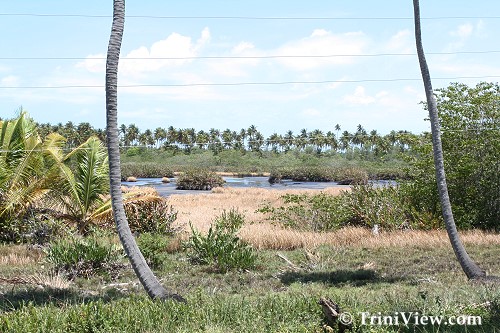 The natural beauty of Icacos
The natural beauty of Icacos
TriniView.com Reporters
Posted: May 10, 2007
The journey to the last point of Trinidad in the southwestern end of the island, the village of Icacos, was a long one but every moment of the trip was well worth it. The day was radiant and ideal for sight-seeing: the sky showed-off its brilliant blue; the few clouds in the sky added soft drops of fluffy balls to the blue canvas; and the sun completed the heavenly scene with a spot of gold that illuminated the colourful earth below.
What was also amazing were the various shapes and textures of the earth that ranged from the busy, multicolored roads, vehicles and high-rise buildings of San Fernando in the city, to the more serene, naturally pigmented, soft textures of Icacos with the tall green and yellow silky leaves and rugged barks of coconut trees; the grey, misty, dry, chilling forms of teak trees; the mellow blues of the ocean; the golden waves of burnt grass; the mystical appeal of old wooden houses; and the dark, snaky bends of the long Southern Main Road.
Before reaching the remote Icacos village, TriniView.com journeyed along the Southern main road passing through areas such as La Brea, Vessingy, Guapo, Cochrane, Point Fortin, Coromandel, Chatam and Granville. Each area had a unique something that distinguished it from another. For example, the southern main road in Chatam was lined with trees and shrubs of all types, whereas Cedros mainly had miles of teak trees on either side of the road and coconut trees characterized the area from Fullerton Road to Columbus Bay.
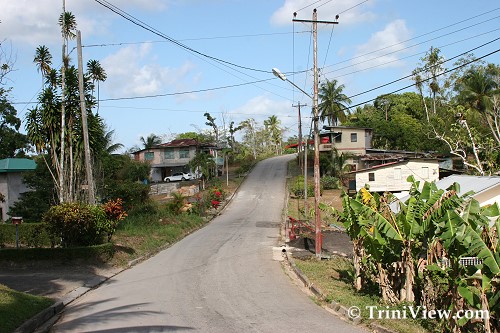 Along Syfoo Trace to Granville beach
Along Syfoo Trace to Granville beach
What was also noticeable was the slow industrialization rate of the area after Point Fortin to Icacos. Although there are few industries in these areas, more archaic forms of industry exist such as farming. Also, in terms of the housing, most of them are made out of wood and fewer out of concrete adding to the antiquity of the area.
The journey though the southwestern peninsula also offered the spectacular view of beaches such as Granville Beach, Cedros Beach and Columbus Bay with the 'Three Sisters' (the three protruding rocks in the bay) as a main site. Although they were quite inviting, not too many persons were there, which may be attractive to those who like to sea-bathe in relative isolation.
Passing through the Coromandel area, we met a group of girls who were quite willing to show us around the area. They were sisters Amanda, Catherina and Samantha Coomansingh and close friend and neighbour, Seeta. They took us to Barran Trace, Coromandel, where they live and gave us a tour of the area. The narrow lane from the corner of Barran Trace leads to an expanse of land used primarily for agriculture such as for growing watermelon and hot peppers and for fishing. In fact, we were amazed at the size of the bhagai plant which stood as high as five feet. The girls also explained that during the rainy season, the river that runs through the land, which was dried up when we went there, has many fish which they catch and eat. However, it also contains caiman which renders it dangerous for bathing.
We were later introduced to other members of the family when we visited their home: Cathy-Ann, Jamani, Shania and Minkey, Seeta's pet monkey. While there we observed their beautiful garden with plants such as bougainvillea, hibiscus, double hibiscus, lemon Portugal and watermelon. Other creatures observed in the area were the typical domestic dog, goats, different species of birds and insects.
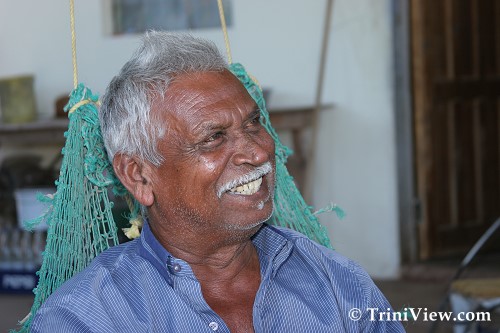 Mr. Boodoo Ramsaroop, villager of Icacos
Mr. Boodoo Ramsaroop, villager of Icacos
On arrival at Icacos, we met residents Mr. Mannie Kanju and Mr. Boodoo Ramsaroop and had discussions with them.
Mr. Boodoo Ramsaroop said that he lived in the village all his life except for a brief period in Constance Estate (where coconuts and their by-products are manufactured) where he lived in the barracks and worked for about 25 years. However, after a nine month strike in the 1960's for union reformation with regards to wages, the worker's stuff was put out on the road and the employees left.
Life as a youth in this village was a quiet one, according to Mr. Ramsaroop. He finished school at about age 14, then started to work immediately after. He got married at age 19 to Golah Ramsaroop and had eight children, two of whom have passed away. In 1976, he worked as a PTSC bus conductor on the Point Fortin/Icacos, Point Fortin/San Fernando route as well as in Fyzabad.
Mr. Ramsaroop said that he loves the country more than the town because you can get fresh things here and it is not congested like the city.
At the moment, Mr. Ramsaroop is retired and spends much of his time sea-bathing and liming with friends.
The second person we talked to, Mr. Mannie Kanju, also a resident of Icasos, is a fisherman by profession. According to Mr. Kanju, about 20 years ago, the cost of living was not so high, so that although you worked for a little money you got its worth. He explained that in those times, he would give his wife twenty-five dollars to make a fortnight's grocery but today, the cost of living is several times higher and twenty-five dollars can't get you that far. Mr. Kanju is a father of six and explained that he could have easily fed them during that era because there were plenty of fish to make a decent living, but things are tough now.
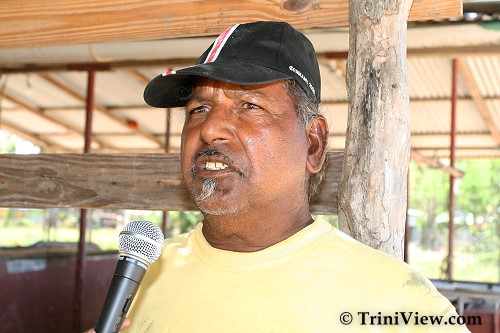 Mr. Mannie Kanju during the interview with TriniView.com
Mr. Mannie Kanju during the interview with TriniView.com
Mr. Kanju explained that although things are not what they were before, he loves fishing, his livelihood. The experienced fisherman who has been doing this for about forty years explained that he always makes a nice catch but that you have to understand the skills of this type of trade: sometimes when you make a big catch you get a lesser price and when you catch less fish you get more value for it. There is no standard price for fish and the only stabilized price is the red fish price which is a little over $10.00.
During his rendezvous to sea, he catches all types of fish: salmon, cariete, cavali, red fish and shrimp. They usually fish in a southwesterly direction and sometime in the east along the Erin/Moruga area. Fish can no longer be legally obtained across the border in Venezuelan waters which contains the most fish. Still, some take the chance.
If the Venezuelan Coast Guard catches them on their borders, which they often do, they may be arrested, prosecuted, and fined. He said that he has been arrested once or twice but isn't too bothered by that. He also told us that he was involved in an incident with someone taking his boat and leaving him out on the Soldado rock which was a story made popular by the press some years ago. He eventually got back his boat.
He has been to Venezuela many times and this is made easier with the port of entry in Cedros which allows them to travel from coast to coast.
Mr. Kaju ended by stating that the laws in the country need to be improved as they relate to the sea. For example, reservation laws which regulate the size of fish and the size and type of net are very restricting and often times not conducive to their work and the environment. He expressed that trolling, for example, should be banned because it damages the grounds and the fish beds which kill thousands of fish every day. However, these laws are hard to change because the 'big town boys' usually have their way.
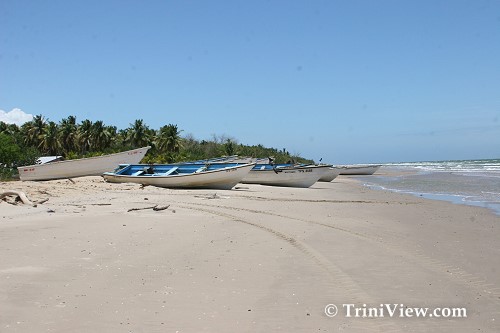 Beach in Icacos
Beach in Icacos
After talking with the two gentlemen, we then journeyed to the coast not too far away. The beachfront was lined with boats which are used for fishing, and from the coast, neighboring Venezuela was easily seen. What was peculiar was that the sea waves, instead of crashing onto the shore in a back and forth motion, ran very speedily from west to north. It was explained that the waters were fed by the large, fast-flowing Orinoco River in South America. This type of rough sea was what Columbus described in his memos and hence one can understand why the sea, Serpent's Mouth, was so named.
Although we enjoyed the unique beauty of the beach, we were earlier warned by the Coomansingh clan that we should keep our shoes on because we could be bitten by the jigger (Tunga penetrans ) parasite which lays its eggs in the feet of its hosts and leads to Tungiasis. Some of the symptoms of Tungiasis are extreme itching, pain, inflammation, fibrous cysts, bumps, lesions, ulceration and discharge from the ulcer. If left untreated, secondary infection such as bacteremia, tetanus and gas gangrene can occur.
Not too far away was the Constance Estate which we visited. There we saw the old coconut factory which is still in operation with its barracks or housing for workers, a main processing factory, a carpenter's shed which housed coconut husks, and an animal pen which housed cattle called Buffalypso. The Buffalypso are a specially bred cattle (possibly a mixture between buffaloes and cows) and are large and intimidating creatures. When we approached the pen, the sensitive creatures who were bathing in the pond of mud, immediately became alert and assumed a majestic, dignified and strategic stance as if readying themselves for battle. However, realizing that we were there only to observe, they became less tense while never losing their watchful eye.
After reaching the last, southwestern part of Trinidad and interacting with the people and the environment, we left the wondrous place vowing to return one day.
Also Read:
A Brief History of Icacos
Journey to Icacos in pictures:
www.triniview.com/gallery/main.php?g2_itemId=171041
Homepage | Carnival | Special Events | Photo Gallery
|
